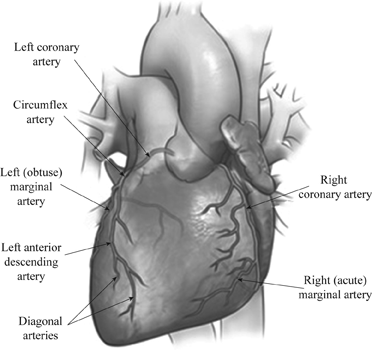Number Of Diagonal Arteries | They extend over the left ventricle in a diagonal fashion toward the acute margin and the cardiac apex. They often run parallel to one another and are variable in number (often 2 to 9). The first diagonal (d1) branch tends to be the most. If a ramus intermedius artery is present, the diagonal arteries are less prominent and arise more distally.
The first diagonal (d1) branch tends to be the most. They extend over the left ventricle in a diagonal fashion toward the acute margin and the cardiac apex. If a ramus intermedius artery is present, the diagonal arteries are less prominent and arise more distally. They often run parallel to one another and are variable in number (often 2 to 9).

If a ramus intermedius artery is present, the diagonal arteries are less prominent and arise more distally. The first diagonal (d1) branch tends to be the most. They extend over the left ventricle in a diagonal fashion toward the acute margin and the cardiac apex. They often run parallel to one another and are variable in number (often 2 to 9).
If a ramus intermedius artery is present, the diagonal arteries are less prominent and arise more distally. They often run parallel to one another and are variable in number (often 2 to 9). They extend over the left ventricle in a diagonal fashion toward the acute margin and the cardiac apex. The first diagonal (d1) branch tends to be the most.

They often run parallel to one another and are variable in number (often 2 to 9). The first diagonal (d1) branch tends to be the most. They extend over the left ventricle in a diagonal fashion toward the acute margin and the cardiac apex. If a ramus intermedius artery is present, the diagonal arteries are less prominent and arise more distally.
They often run parallel to one another and are variable in number (often 2 to 9). If a ramus intermedius artery is present, the diagonal arteries are less prominent and arise more distally. The first diagonal (d1) branch tends to be the most. They extend over the left ventricle in a diagonal fashion toward the acute margin and the cardiac apex.

They often run parallel to one another and are variable in number (often 2 to 9). If a ramus intermedius artery is present, the diagonal arteries are less prominent and arise more distally. They extend over the left ventricle in a diagonal fashion toward the acute margin and the cardiac apex. The first diagonal (d1) branch tends to be the most.
Number Of Diagonal Arteries: They extend over the left ventricle in a diagonal fashion toward the acute margin and the cardiac apex.
0 comments:
Post a Comment